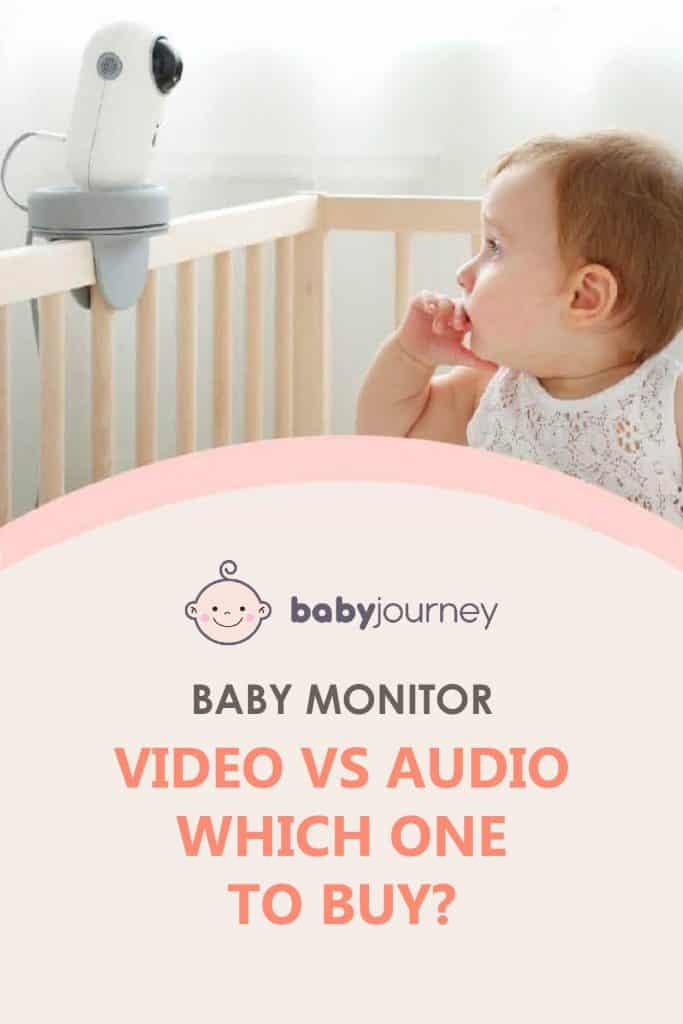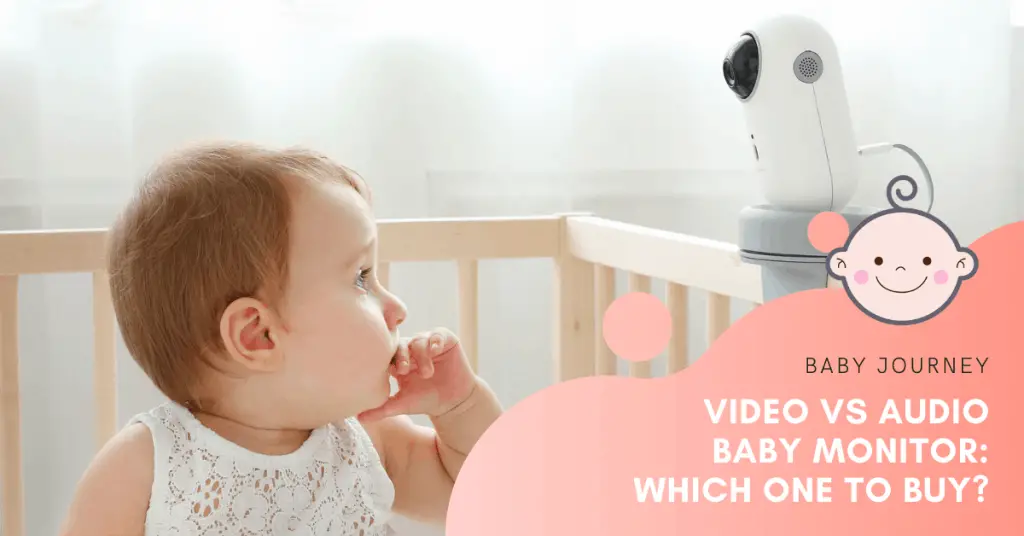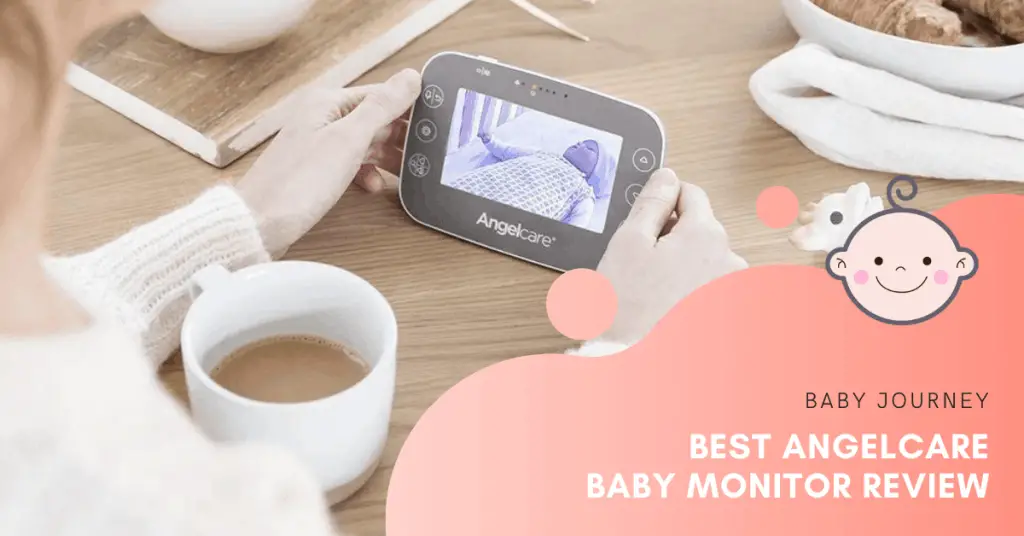Are you confused between a video vs audio baby monitor? Parents have been increasingly depending on baby monitors, and as a mother, I am included as well.
I personally favor video monitors for their convenience over audio baby monitors. They let me watch my little girl as well as hear her all the time. Of course, choosing a baby monitor over the other truly depends on your needs when it comes to caring for your little one.
For first time parents, deciding between the different types of baby monitors can be confusing. Let’s get into the details of video monitor vs audio monitor and help you figure out which one is more suitable for you.
Video vs Audio Baby Monitor: The Contenders
Whether it’s an audio or video baby monitor, it needs a medium for communication. Basically, there are three types of signals that baby monitors can utilize.
- Analog Monitors: You will see analog transmission in the budget baby monitors. The analog signal is radio waves that the baby units transmit and the parent units receive. Interference is a big issue for analog signals. If there is another signal nearby, the communication between the parent unit and the baby unit might be disrupted.
- Digital Monitors: These monitors use digital signals instead. Digital signals are not prone to interference. It has its own technology to transmit and receive signals and is used for video or audio baby monitor.
- Wireless Monitors: Most modern baby monitors use wireless technology. It can be either wifi or non-wifi signals.
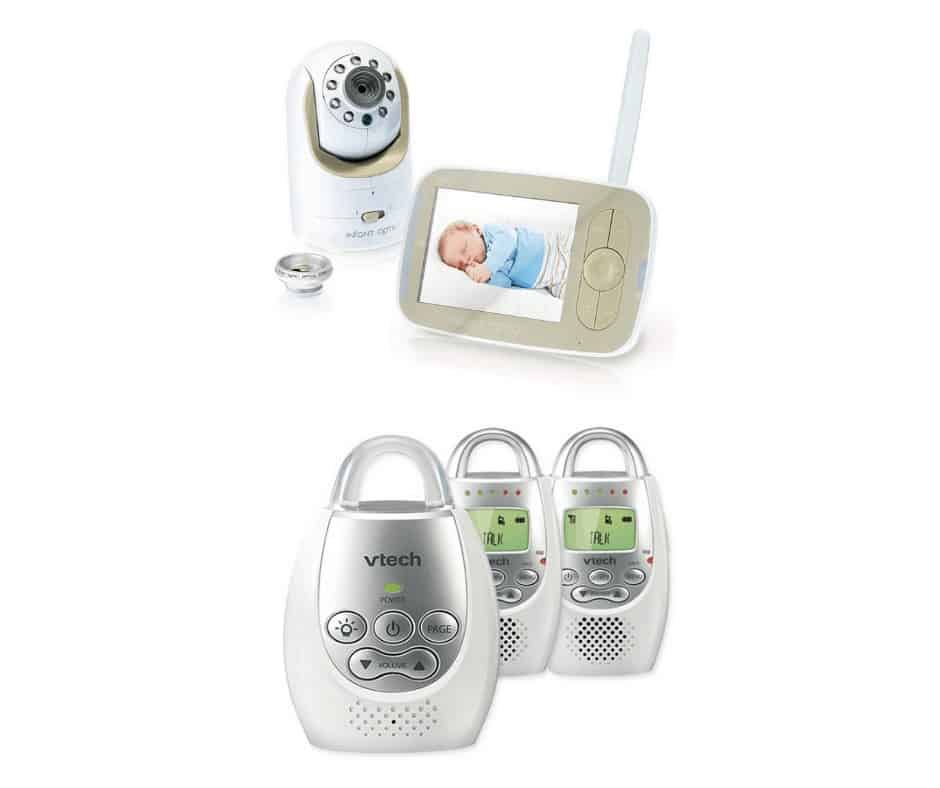
Video Baby Monitor
Video baby monitors are becoming more and more common among parents, including me. Video monitors allow you to watch over without visiting your baby’s nursery every time you hear a sound.
Traditional video monitors usually come with a baby unit and a parent unit. The parent unit comes with a built-in display. Most video monitors nowadays use a secure wireless channel to communicate between the parent unit and the baby unit.
Pros:
- Has video feed
- Camera tilt and pan options
- Available in Wi-Fi and non Wi-Fi variants
- Usually expandable, up to 4 or 5 cameras
- Non Wi-Fi variants use designated channels like FHSS for added security
- Supports night vision
- Optional temperature monitoring
- Two-way communication
Cons:
- Relatively more expensive
- Shorter battery life
- Relatively shorter range than audio monitors
Audio Baby Monitor
Unlike video monitors, audio baby monitors have limited features. They usually have better range, but you have to rely on audio cues and connect the dots yourself.
Audio baby monitors usually have better battery life than video monitors, since they do not have to spend resources on visuals. This also makes them a preferred choice as travel baby monitors.
Pros:
- Almost 1000 feet range
- Multi-level sound indication
- Two-way intercom
- Long battery life
- Portable and travel-friendly
Cons:
- No video displays
- Frequent signal loss
Video vs Audio Baby Monitor: Features Face to Face
Ease of Setup and Usage
In terms of setting up, audio baby monitors like Vtech DM221-2 or Philips ADVENT DECT Baby Monitor are more straightforward. These are ready-to-use models that don’t require a complex configuration since you can plop them on tables and shelves right away.
On the other hand, video monitors are a little more complicated. Most of the time, you have to mount the cameras in the baby’s room and configure the parent unit according to your needs. As video baby monitors require visual feedback, proper placement of the monitor cameras is important.
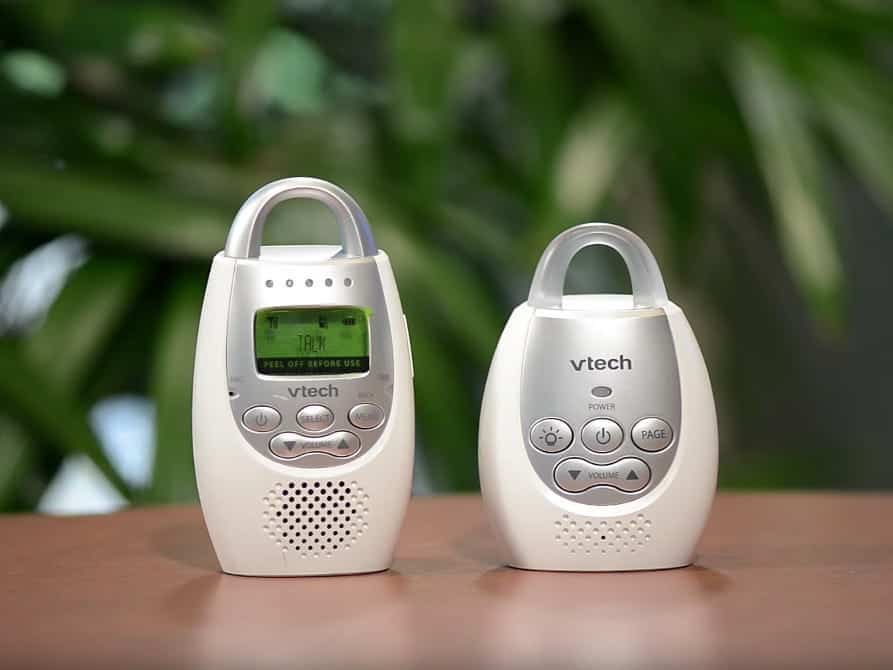
Feedback Type
If I have to consider feedback types, video baby monitors take the win for sure. A video monitor allows me to watch and hear my baby whenever I’m not around.
The cameras are usually quite high-quality for video monitors like Infant Optics DXR or Eufy Security Spaceview Monitor. Along with video feed, these monitors also offer features like temperature monitoring, night vision, and some come with preloaded lullabies.
Moreover, the displays are big enough to see the baby clearly. Most of them even have night vision technology.
On the other hand, audio baby monitors are capable of sending audio signals to the baby monitors but that’s about that. They’re great for budget baby monitoring, portability and for those who aren’t familiar with technology, but they are not my favorite. Both audio and video monitors come with low battery alerts, two-way communication in most cases.
Battery Life
In my journey to judge video vs audio baby monitor, I have found audio monitors to last longer. And for obvious reasons too, since there are no cameras or displays that drain the power fast.
On average, video monitors last about 10-15 hours without being plugged in, while audio monitors tend to last 24 hours or more. The audio baby monitor is the winner here when it comes to longer battery life, and is the better option if battery is something you consider heavily due to difficulty of getting the device charged all the time.
Portability
Whether it’s an audio or video baby monitor, modern technology has made both of them portable and easy to carry around. But from a personal standpoint, I’d say audio baby monitors are more portable – they are more compact and lightweight.
You can just throw them into the backpack and go your way. Some video monitors that have smaller screens, like the Hello Baby HB32 Video Baby Monitor, are quite portable as well, but it’s still audio baby monitors for portability here.

Data Security
Modern baby monitors are far more secure than their predecessors. But there is always a risk of a data breach.
Audio monitors are on the safer side as they usually utilize DECT 6.0, a standard used for cordless telephone systems. Audio baby monitors communicate on a 1.9 GHz channel for minimal interference.
While audio baby monitors use radio signals which might be easier to tune into, a hacker is less likely to get access to any of your personal information, making audio baby monitors a secured choice.
A video baby monitor that uses secure wireless transmission is also very safe. But the monitors that use WiFi to operate are more prone to hackers. If security is a big concern, I would recommend you to stick to audio monitors.
Expandability
Expandability is about being able to add on either more parent units or child units to monitor more than one child or room.
Audio baby monitors are not as expandable as video baby monitors. They often rely on older technology to communicate between the child unit and the parent units so they come configured by the manufacturer, up to 2 parent units at most.
However, video monitors often allow the baby monitor set to be expanded with more cameras. Four cameras are the average for most manufacturers out there, serving as the perfect tool to monitor twin babies or even multiple rooms, unlike audio monitors. The video baby monitor is the clear winner here.

Pricing
Audio baby monitors are better for the budget. If you have a low budget you can go for the audio baby monitors. They are often under $50 which is a great price for a baby monitor.
Video baby monitors are expensive because they come with technology like night vision and tilt/pan lenses for baby monitor cameras. If you have the budget, I’d recommend going for the video baby monitors as they are more robust and give you a better sense of security.
Considering all the features of video vs audio baby monitor, the video variant is clearly the winner for me.
Stand Out Features of Video Baby Monitors
- High-resolution camera: When I think about video vs audio baby monitor, I think about getting the best value out of my baby monitor. Video monitors are certainly better in my opinion as I can both see and hear my child when I’m away. With modern technology, video monitors offer spectacular camera resolution.
It’s often hard to pick up the signals of an audio monitor as we have to determine what the baby is doing. But with a video monitor like Infant Optics DXR-8, I get the visuals as well.
If my little princess is crying, I can look at the monitor and see for myself what is wrong. It’s a feature no audio baby monitor can provide.
- Night vision: When talking about video monitors, there’s no way I’m going to skip the night vision feature. Even in the dark, I can see my baby. It’s a neat little feature most modern video baby monitors come with.
- Camera tilt/pan: Days of static camera angles are gone with baby monitors. Most video baby monitors on the market are capable of zooming in, tilting or panning the camera as required. It gives a larger area to cover for the parent unit.
Why I’d Prefer a Video Baby Monitor over an Audio Baby Monitor
For a lot of parents, investing in baby monitors seem like a luxury. It’s especially true for video monitors.
As a concerned mother, I’m all in for a video baby monitor for the conveniences it offers. Let’s take a look at some of them.
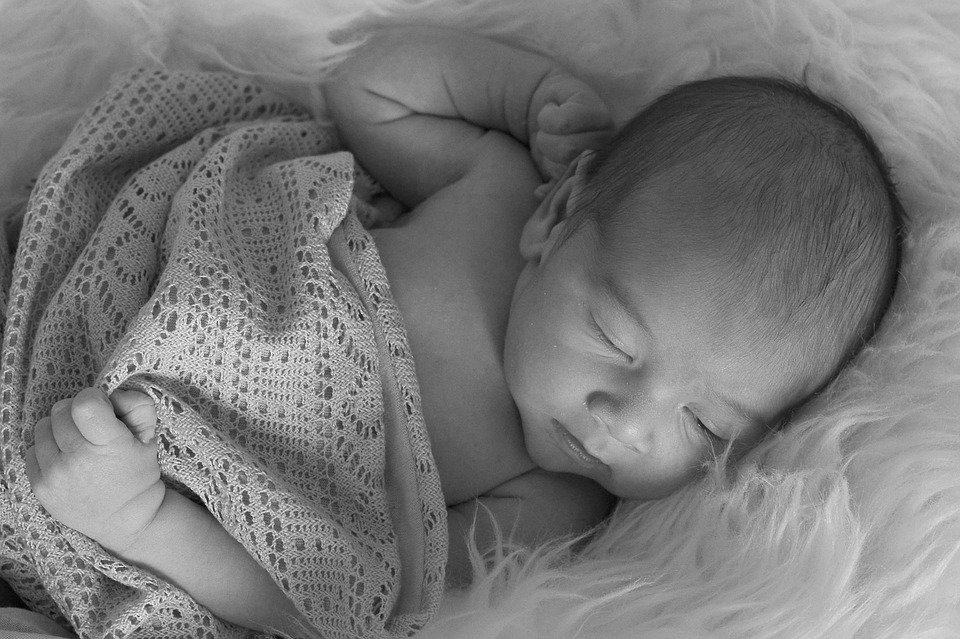
- Helps with Sleep Training: Sleep training is one of the most challenging steps new parents must go through. Understanding what a newborn or a toddler wants is very hard as all you can hear is the scream.
In most cases, there is no particular reason behind your baby’s cries. They just like attention. And in such cases, a video baby monitor comes in very handy.
You can keep a close eye on the baby and see for yourself whether he/she needs your attention or not. If not, you can let the baby cry-it-out. It might sound like a cruel thing to do, but it’s one of the easiest methods of sleep training.
- Value for Money in Monitoring Children from Newborn to Toddler: Another reason why I prefer video baby monitors over an audio one is the value for money in the long run. A newborn has limited mobility, and you don’t have to worry about the baby getting hurt inside the crib.
But as they grow older, they become mischievous. And that’s when the value of a video baby monitor kicks in. Video baby monitors are great for long term use as it will last through the newborn phase to the toddler phase, and even more, if you see fit.
- Better Reassurance than Audio Baby Monitors: The biggest reason why I like video baby monitors so much is the reassurance I get before I no longer need to monitor my baby. I do like to check on my little girl in person, but it becomes tiring after a few unnecessary visits.
With a video baby monitor, I don’t have to rush to the room to see what’s wrong. I just take a look at my monitor. No audio baby monitor can give me such reassurance.
Smart Baby Monitor, a Greater Contender to Video vs Audio Baby Monitor?
Smart baby monitors are the ones that use Wi-Fi to connect to your smartphone or tablet. Smart monitors are the latest addition to the arsenal of baby monitoring products. They offer some outstanding benefits over any video or audio baby monitor, especially since most have both video and audio capabilities combined plus other nice features like sleep tracking or movement monitoring.
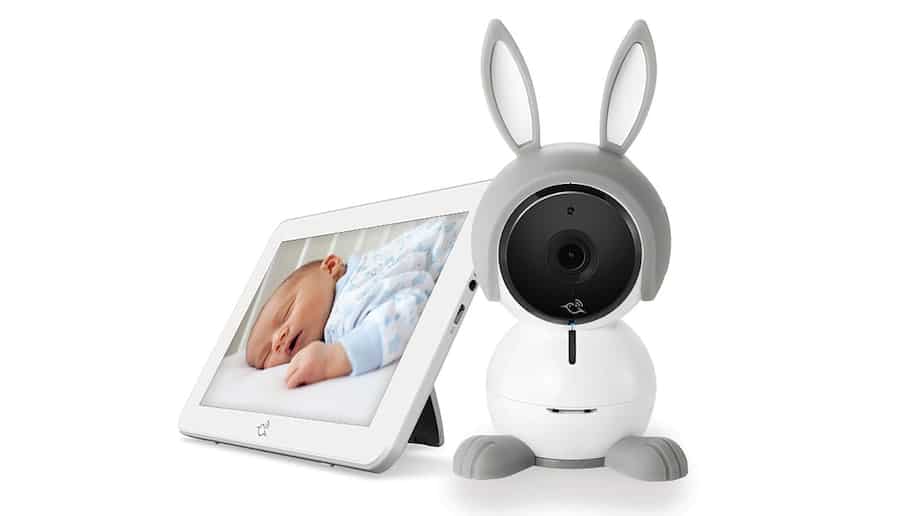
Some of the best smart baby monitors include the Arlo Baby monitor, the Owlet baby monitor, and the Mimo Baby monitor.
So how does a smart baby monitor compare to a video or audio baby monitor? Let’s take a look at the pros and cons:
Pros
- A smart baby monitor uses Wi-Fi to connect to a smartphone or tablet, eliminating the need for carrying an extra parent unit.
- Some smart baby monitors allow you to connect with smart speakers like Amazon Alexa or Google Assistant. As a result, you can control the baby monitor with voice commands!
- Smart baby monitors offer remote monitoring. Traditional baby monitors, both audio and video, come with a limited range. You go outside the range, and you lose the signal. But smart monitors are connected via Wi-Fi so you can check on your baby from anywhere in the world.
- Lastly, a smart baby monitor allows you to connect multiple devices with the camera. It’s usually done via a baby monitor app that contains all the features of the monitor as well.
Cons
- There are no significant cons to smart baby monitors except for their high cost and vulnerability. As these baby monitors connect over WIFI, a persistent hacker might get access to the data, or even talk through the speaker.
- High-end models of smart baby monitors use top of the line security measures to keep hackers at bay, but they are fundamentally more vulnerable than traditional baby monitors.
Conclusion
While choosing a video or audio baby monitor, remember the features I mentioned above to help you in the decision process. Let’s sum it up.
Get a video baby monitor if:
- You want visuals on your baby
- You have the budget for a good baby monitor
- You want to watch over your child in the dark
Check our review of the best video baby monitors for ideas!
Get an audio baby monitor if:
- You’re comfortable picking up audio signals
- You don’t want to spend a lot on a baby monitor
- You want a better range
- You don’t want the risk of a data breach of wireless technology
Read our top audio monitor picks guide to find the best option for your family!
In my opinion, a video baby monitor is a clear winner here. It allows me to watch over my baby with my eyes, rather than depending on a sound cue. It’s safe, it’s packed with features, and I can pan or tilt camera angles. What more could I want!
Do you agree that video baby monitors are the way to go? Share your thoughts below!
—
